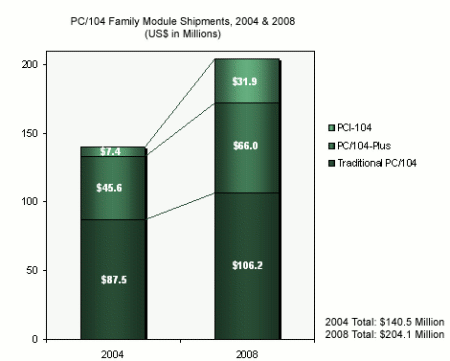PC/104 stacks up growth
Mar 16, 2005 — by Henry Kingman — from the LinuxDevices Archive — views The market for PC/104 modules shows “strong and continuing viability,” according to a study of the global marketplace by VDC (Venture Development Corporation). PC/104, PC/104-Plus, and PCI-104 are set for growth over the next four years, with PCI-104 the fastest growth segment, the research firm says.
The market for PC/104 modules shows “strong and continuing viability,” according to a study of the global marketplace by VDC (Venture Development Corporation). PC/104, PC/104-Plus, and PCI-104 are set for growth over the next four years, with PCI-104 the fastest growth segment, the research firm says.

The PC/104 module market will grow 45 percent over the next four years, according to VDC
(Source: VDC © 2005)
PC/104 defines a 3.6 x 3.8 inch form-factor for self-stacking modules intended for use in embedded systems. The specification was authored in 1991 by Rick Lehrbaum, then CTO of single-board computer vendor Ampro (Lehrbaum went on to found LinuxDevices.com, and currently serves as executive editor here).
 According to Lehrbaum, PC/104's 104-pin socket interface was created by converting the PC/AT bus — also known as the ISA bus — to a pin header format. “There was an original PC bus that had 62 signals, if I remember correctly, and we added 2 grounds and made that the 64-pin PC/104 P1 connector. Then we added the 38-signal PC/AT motherboard card edge extension along with extra grounds for a 40-pin P2 connector. So, 64 plus 40 equals 104.”
According to Lehrbaum, PC/104's 104-pin socket interface was created by converting the PC/AT bus — also known as the ISA bus — to a pin header format. “There was an original PC bus that had 62 signals, if I remember correctly, and we added 2 grounds and made that the 64-pin PC/104 P1 connector. Then we added the 38-signal PC/AT motherboard card edge extension along with extra grounds for a 40-pin P2 connector. So, 64 plus 40 equals 104.”
According to VDC, the original ISA-bus version of PC/104 represented an $87.5 million market in 2004, and will grow to $106.2 million in 2008, an increase of 21 percent in dollar volume. The form-factor will continue to see use primarily in industrial automation applications that do not require high-speed response. However, the ISA bus has been absent from consumer desktop computers for several years, so demand for and a supply of controller and bridge chips will eventually decline, VDC says.
PC/104-Plus
As the PCI bus began to replace the ISA bus in the mid to late 1990s, the PC/104 Consortium produced the PC/104-Plus specification, which added a PCI bus. Says Lehrbaum, “We added PCI on the opposite end of the module. So, you could have 8-, 16-, and 32-bit bus versions of the modules.”
VDC says the market for PC/104-Plus modules accounted for $45.6 million in 2004, and is expected to reach $66 million in 2008, an increase of 45 percent in dollar volume.
PCI-104
In February of last year, the PC/104 Consortium created the PCI-104 specification, which does away with the ISA bus entirely, thereby leaving more room on PC/104 modules for other subsystems. According to VDC, PCI-104 represents the fastest growth market for PC/104 technology. It accounted for $7.4 million in 2004, and will reach $31.9 million by 2008, a 331 percent increase in dollar volume shipments. In other words, PCI-104 accounted for 5.3 percent of total PC/104 shipments in 2004, but will account for 16 percent by 2008, VDC says.
Analyst perspective
J. Eric Gulliksen, embedded hardware practice director at VDC, said, “Several small 'stackable' embedded motherboard form factors, including 3.5-inch, 5.25-inch, EBX, and the new EPIC, may be provided with PC/104 family expansion. These provide a wider range of choices for designers when selecting a control module. Pentium-M and Celeron-M CPUs, with power-and-clock stepping technologies, are enhancing the computing power capabilities of these small boards, without aggravating thermal problems.”
Gulliksen added, “I wouldn't be surprised to learn of a program to apply PCI Express to the PC/104 family form factor in the near future. This would provide for increased performance and reduced board complexity, and further solidify the position of stackable architectures in the embedded world.”
Lehrbaum said, “If you had told me back in 1991 that PC/104 would be going strong in 2005 — and even growing robustly — I'd have said you were crazy.”
Additional details about VDC's study, “The 2004 Merchant Computer Boards for Embedded/Real Time Applications Market Intelligence Program – Volume IV: Stackables,” are available online.
This article was originally published on LinuxDevices.com and has been donated to the open source community by QuinStreet Inc. Please visit LinuxToday.com for up-to-date news and articles about Linux and open source.